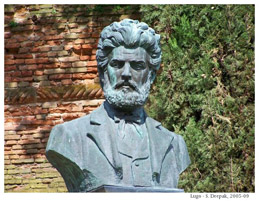 Lugo, Emilia-Romagna
Lugo, Emilia-Romagna
Lugo is a town and comune in the northern Italian region of Emilia-Romagna, in the province of Ravenna..
A settlement in where is now the city is mentioned for the first time in 782 AD, but the names Lucus appears only in 1071. In 1161 it was a fief of the Counts of Cunio, but in 1202 it returned to the Papal States. It was later a possession of the Da Polenta, Pepoli, Visconti and Este; the latter maintained it until 1597, when the city was again annexed to the Papal States.
In 1424 the Castle of Zagonara (now destroyed) was the seat of the homonymous battle, in which a Milanese army defeated the Florentines.
When the French revolutionary forces invaded northern Italy in 1797, Barnaba Chiaramonti (later pope as Pius VII), then still Bishop of Imola, addressed his flock to refrain from useless resistance to the overwhelming and threatening forces of the enemy. The town of Lugo refused to submit to the invaders and was delivered up to a pillage which had an end only when the prelate, who had counselled subjection, supplicantly cast himself on his knees before General Augereau.
In 1859, through plebiscite, Lugo joined the newly born Kingdom of Italy. During World War II, the Senio river formed the frontline between the German and Allied occupation areas from December 1944 until 10 April 1945. The city suffered heavy destruction but recovered quickly after the end of the conflict.
View Gallery.
 MAIN SIGHTS
MAIN SIGHTS
|
|
| The Pavaglione, former 19th century covered market (mainly known for silkworm trade). |
|
| The Oratorio of Croce Coperta, with 15th century frescoes. |
|
| The 'Collegiata' church, rebuilt in the 18th century over a 13th century Franciscan edifice, has a suggestive 15th century cloister. |
|
| San Francesco di Paola (1890), houses a precious polychrome terracotta sculpture of Dead Christ (15th century). |
|
| Teatro Rossini, now a 445-seat opera house, completely restored between 1984 and 1986 based on its original conception from 1759 and restoration and expansion in 1821. |